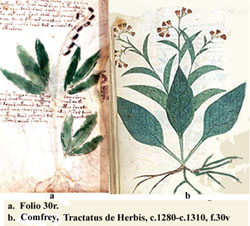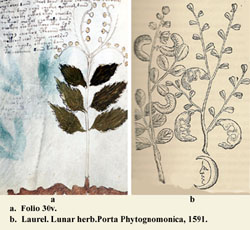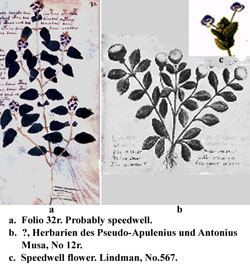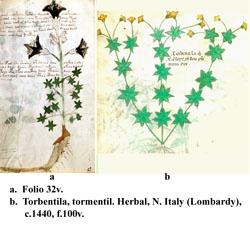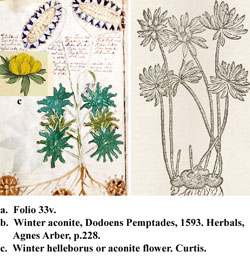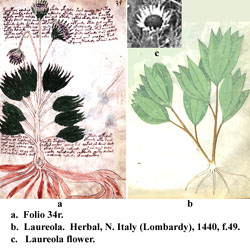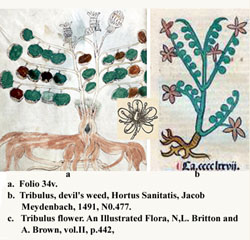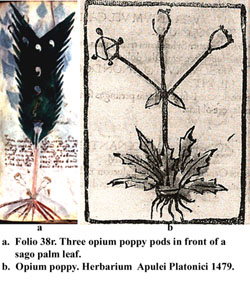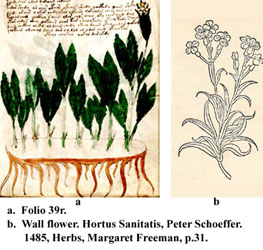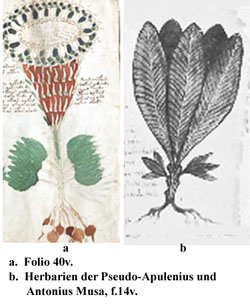The Voynich Botanical Plants
Folio 30r. Comfrey (Symphytum officinale). Contemporary herbalists question the therapeutic value of comfrey. In the past it was used for a variety of ailments ranging from bronchial problems, broken bones, sprains, arthritis, severe burns and various skin conditions. It is reputed to build bones and teeth in children and was used to treat many female disorders. (1) (B)
Folio 30v. Bay laurel (Laurus nobilis). The bay leaf is used in seasoning, particularly Mediterranean dishes. A laurel wreath was used as a prize in Ancient Greek games. An astrological herbal claims “that if the marigold is gathered, the Sunne beynge in the sygne Leo, and wrapped in a leafe of a Laurell or baye tree and a wolves tothe be added there to, no man shall be able to have a word to speake against the bearer but woordes of peace.” (3) (B)
Folio 32r. Speedwell (Veronica officinalis). The Romans discovered Veronica during their conquest of Northern Europe and named the plant “the world medicine.” It eases digestion and helps bowel movement, increases memory, reduces verdigo and has a calming effect. It has even shown to be very helpful in the treatment of depression. (1) (B)
Folio 32v. Tormentil (Tormentilla erecta). The extremely bitter rhizomatous root produces a red dye that is used to dye leather red. The roots are used to flavor a bitter Bavarian liqueur and is the main ingredient in a medication for diarrhea. (1) (B)
Folio 33v. Winter aconite (Eranthis heymalis). This is the folio the botanist Hugh O’Neill, identified as a sunflower, dating the VM to a post Columbus date, which from the carbon dating results is incorrect. I feel confident that this folio represents the small tuberous plant, winter aconite, that is one of the first plants in alpine regions to flower in the spring. It is a member of the ranunculaceae family and all parts of the plant are poisonous. (B)
Folio 34r. Ox-eye daisy (Callilepis laureola). This plant is native to South and East Africa. It is a perennial herb with stems sprouting from a large, poisonous, woody tuber. The Zulu use an infusion of the tuber as a purgative and to treat tapeworm, snakebite, infertility, as a pregnancy tonic and to kill maggots in cattle. Fatalities have occurred from an overdose. (1) (B)
Folio 34v. Devil’s weed (Tribulus terrestris). The fruit, leaves and root of this plant have been used for a variety of complaints, particularly for kidney and urination problems. Today it is used to increase testosterone in men after they have completed an anabolic steroid cycle. However, although it increases some hormones in animals, there is no evidence that this is the case in humans. (1) (B)
Folio 38r. Opium poppy (Papaver somniferum). The use of opium predates the ancient Greeks. Opium is obtained when the green seed pod of the poppy is cut and the latex harvested and later dried. Morphine and its derivative heroin are the main alkaloids obtained. Apart from its effective way of relieving severe pain, opium was used for treating asthma, stomach illnesses and bad eye sight. Poppy seeds are used in baking. (1) (B)
Folio 39r. Wallflower/gillyflower (Erysimum). Hortus Sanitatis states that “the flowers smell like violets and the yellow ones are the best in medicine. Juice of the flowers put in the eyes takes away the wicked specks there in. Water of the distilled flowers drunk noon and night for 3 to 4 weeks doth cause women to be fruitful. It is good for all hard labor in childbirth, paralysis, dropsy and the chaps which are in the seat.” (2) (B)
Folio 40v. An unknown plant. (B)
